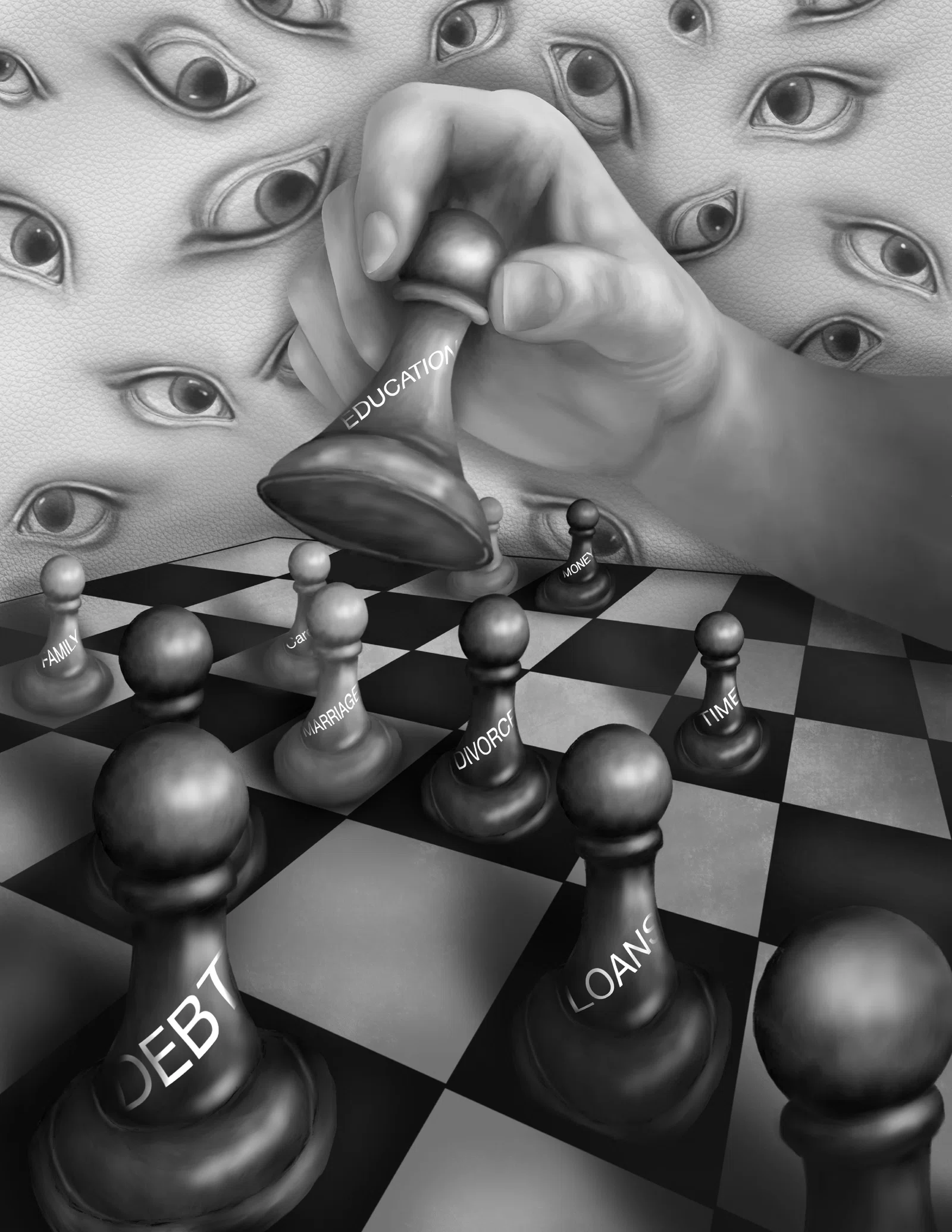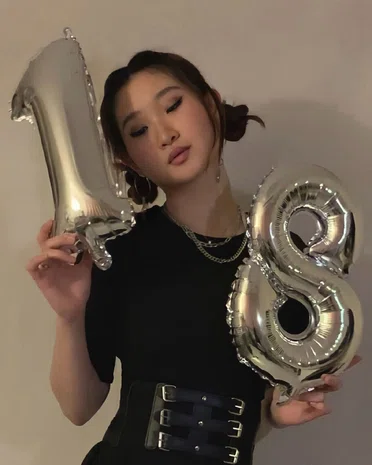







2-D Design
Angela King
Zama Middle High School|Zama, Japan

Checkmate|21.5 x 16.5 in.
Material(s): Procreate fill tool=brightened text. Skin texture brush=background texture. Grayscale=unfulfilled life.
Process(es): Experiment w/old skin=cracking under societal pressure. Eyes watching chess pieces move=life choices
Curatorial Note: Example of strong poster design


“As a Korean American, I was surrounded by Korean stories. Later, I saw the societal struggles found in these stories and the reality depicted. These folktale lessons are still important today.”

Student statement
Student
statement
My sustained investigation started with how I could compare and contrast traditional Korean culture and folktales to modern Korean society. However, as I progressed through my portfolio, I realized that my investigation should not solely focus on Korean modern society but today’s society as a whole. Therefore, my sustained investigation was guided by the question of how I could juxtapose traditional Korean folktales with modern social and societal issues. Each piece featured in my portfolio demonstrated the relevance of different traditional stories in modern society. The title of the piece above is called Checkmate, and was influenced by a famous Korean folktale that taught lessons of conformity and to act in accordance with expectations. I quickly related the tale’s main ideas to the struggles of many people today, which is living in accordance with what society has deemed appropriate and acceptable. We learn to conform and work hard towards approval only to realize that it isn’t as fulfilling as society advertised. We have freedom in our own lives. However, we are greatly influenced by societal gazes and feel pressured to achieve certain milestones in order to be “successful” or “accepted.”
To depict the strategic life choices we make in accordance with social norms, I illustrated a chess game to symbolize societal expectations and how we conform to them. The chess pieces identify general life milestones we are expected to fulfill as well as the consequences and risks of those actions. The player is carefully maneuvering their pieces under the gaze of everyone else. The eyes in the background illustrate the feeling of being watched by society and fearing negative reactions if a certain life decision is not executed “correctly.” The old and cracking skin texture further represents the fear of watchful eyes as well as cracking under societal pressures. Lastly, I purposely crafted this art piece in a monotone grayscale to illustrate a bleak and unfulfilled life of conforming. Just like in chess, your life has millions of different possibilities. Don’t let certain views and expectations confine you into tiny black-and-white squares.

Angela King

Material(s): Procreate brushtool=highlights/shadowsText tool=emphasis life milestonesCopynpaste=repeat eyes/pcs
Process(es): Revised sketch, removed symbol on boardAdded highlighted text/enlarged pieces=societal expectations
I would have not been able to finish this portfolio without the loving support and guidance from Ms. Rosa. She helped us AP students step out of our comfort zones and expand our skills. Ms. Rosa gave us every opportunity to better our work and handed us all the materials we need to succeed not only in this course but in life as well. Thank you Ms. Rosa!
Teacher Statement
Teacher Statement
Lauren Rosa
Having taught AP Art and Design for ten years, the portfolio of earlier years seemed to be more of a “one size fits all” with instruction mostly teacher directed and students exploring a concentration in a variety of ways. However, the changes made in the past couple of years have made me recognize and embrace a different approach to the inquiry and investigation driven by students. The reinvention of the art and design portfolios has made me rethink my AP teaching approach to students. I feel that the AP experience in my classroom is a unique, individualized, student-directed inquiry-based process facilitated through one-on-one instruction, questioning student’s intent, providing ideas of constructing/deconstructing compositions, exploring various media and methods, utilizing individual critique to provide suggestions, researching ideas, and hopefully, pushing students out of their comfort zone to experiment and reach new levels with their work that they thought were impossible.

This year was transformative for me as an AP Art and Design teacher due to a “refresher” AP workshop facilitated by Barbara Sunday. After day one of the training, I was excited and reinvigorated. I had so many ideas and practices to share with my students that I contacted them right after the workshop completed that day to readdress their first completed piece because I had reservations. I thought the pieces were missing something and were too literal like an illustration rather than an investigative piece tying to the inquiry. I told them we would discuss it further on Monday and I wanted them to pause what they were working on to create a mind map, not one with spokes on a wheel but one with branches extending in a myriad of directions. On Monday, I sat with the students and we discussed creating layers to synthesize the intent of the subject matter along with making deliberate material choices to demonstrate the elements/principles and assist with conveying the intent of each piece in relation to the sustained investigation inquiry question. I also emphasized documenting their process and making each decision purposeful in relation to their practice, revision, and usage of materials, not like a step by step tutorial. The students took it all in and “marinated” over what we discussed.
The AP workshop was filled with many revelations and “a-ha” moments that really energized me. It gave me a new perspective and helped me convey what I thought was missing from my students’ work, causing me to exclaim to my two AP students that we were setting the bar at 5’s this year. The students initially thought I was crazy, but I believed in them and my “light bulb” had gone off, providing me with a greater understanding of the portfolio expectations, which led them to believe too and they pushed their boundaries.
With Angela specifically, I felt the more we discussed the correlation between layers to demonstrate practice, revision, experimentation, and connection between intent, materials, and the elements and principles, the more she rose to the challenges and pushed herself to new levels with her work. Every piece of advice, critique, or suggestion was taken in, internalized, and reinvented or readdressed in her work. She saw my passion and enthusiasm and was open to experimenting and revising her pieces, which I felt were too literal and did not connect with the symbolism she wanted to demonstrate tying to her inquiry and intent. We discussed the wording of her investigation question, looked at the sketch and piece, and discussed deconstructing/recreating compositions more suited to the morals of the Korean folktales, while connecting to today’s societal issues. We did these one-on-one discussions and critiques throughout the year with each sketch, development of the piece, and final composition. She even further revised works after they had been evaluated. Angela took in every verbal and written comment; she made notes, thought about what we discussed, and made improvements as needed. In some cases, she digitally enhanced the piece to add more contrast or highlights, reconstructed to provide more synthesis of materials, or even, deconstructed a piece to reinvent it. I learned so much from Angela’s openness and willingness to really “listen” and revisit pieces, making them even more impressive. Each time, I was blown away with how she incorporated the suggestions and created one fantastic inquiry based piece after another, while keeping pace with the deadlines. It shows in her body of work and particularly in the selected work for this year’s AP exhibition. In conclusion, my advice to other teachers is to trust the process and focus on the inquiry, use layers to synthesize the materials to the elements and principles tied to the composition, utilize AP classroom as a supplemental tool, and push students out of their comfort zone to explore new media and methods.
Principal Statement
Principal Statement
Henry LeFebre
What are you most proud of regarding your school’s AP Art and Design program, student, and teacher?
I am so proud of Zama Middle High School’s AP Art Program, Mrs. Rosa, our teacher, and Miss Angela King, one of our most talented students. Even during the grips of a worldwide pandemic DoDEA, Zama Middle High School’s AP program, our teacher and our students were able to maintain our steadfast commitment to the fine arts.
What do you do to support art students and art teachers in your school?
I believe every student has a talent. Exploring, determining, and honing that talent is the roundabout mission of every school. With this in mind, ensuring our students have access to academic and extra-curricular activities is paramount. That is my personal mission, ensuring our students are afforded the opportunity.

What is your advice to other principals on how to support an AP Art and Design program?
My advice to other principals in support of AP Art and other Fine Art’s classes is to maintain a balanced approach to providing academic Fine Arts classes as well as extra-curricular activities.
Angela King














